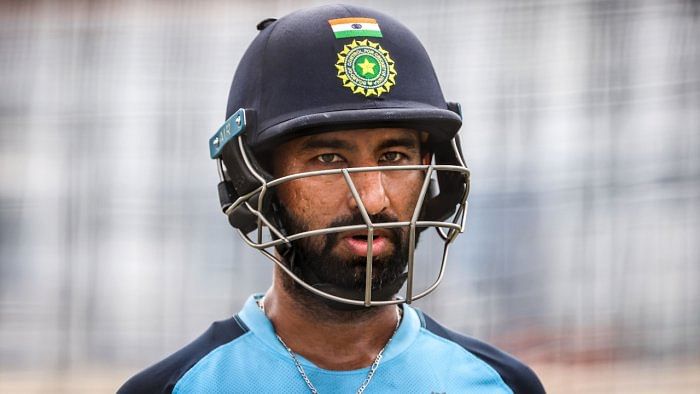
Precisely five months ago, the blue-chip Cheteshwar Pujara stocks touched an unprecedented high at what’s referred to as the Gabbatoir. On the most Australian of surfaces, against a hostile attack suddenly alive to the possibility of being vanquished in its fortress, India’s unflappable number three put on an exhibition for the ages. On show wasn’t a dazzling array of jaw-dropping strokes. That he left to the pretty young things, Shubman Gill and Rishabh Pant. What Pujara displayed was courage and steel above and beyond the call of duty.
For five hours and 211 deliveries, he stood like the immovable rock in the ultimate tribute to the man he succeeded at the one-drop position, Rahul Dravid. Immovable, only because he decided so. Mitchell Starc, Josh Hazlewood and Pat Cummins unleashed a fusillade. Pujara met most of them with the broadest of blades; when the ball evaded his willow, he offered head, torso and limb as the second line of defence.
A lesser man might have given up the ghost long, long back. Pujara, unflinching even as he was hurting all over, responded to every body blow with a neutral stare at the bowler, wrapped his hands tightly around the bottom of the bat handle and settled back into his stance, ready to put the body on the line again if so required. It wasn’t pretty, no sir; few things about Pujara are. But what he lacks in aesthetics, he more than makes up for with a bloody-mindedness unlikely to leave mate or opponent untouched.
Pujara’s returns on that historic day when India chased down 329 and became the first team to conquer the Aussies at the Gabba since 1988 were 56. Gill kicked off the epic chase with a fluent 91, and Pant completed it with a masterful, cheeky, unbeaten 89. But Pujara was the glue that held the innings together even though he had no business standing after copping one sucker punch after another after another.
It’s said, and not without reason that a batsman’s approach to his craft is indicative of his personality. Dashing and debonair on the park, Virender Sehwag is as carefree off it. Dravid’s meticulousness at the crease is mirrored by his carefully structured career path. VVS Laxman is as gracefully polite in person as he was apologetically dismissive of the cricket ball. Pujara off the field is understated, unassuming and uncomplicated.
And yet, here Pujara is today, his career at the crossroads. Again. Five subsequent Tests and nine innings since Brisbane have produced just one half-century. But as much as the lack of runs at a pivotal position, it is his approach that’s under the microscope.
To be fair, Pujara has done little differently from the past. Even in the most benign conditions and against less than threatening attacks, his has forever been a circumspect presence for the first couple of hours. It was only after he had bedded in, so to speak, did Pujara venture to parade his stroke-making abilities. India welcomed that version, if only because he made the time spent in the middle count at least four times out of ten. And it’s hardly a secret that when Pujara does so, he makes it count real big.
If the harsh glare of the unforgiving spotlight is questioningly trained on him now, it’s because the law of diminishing returns appears to be catching up. He no longer kicks on from starts with the same frequency as before, and because the tall edifices are becoming increasingly conspicuous by their absence, Pujara’s almost static, run-free occupation of the crease at the start of his foray is becoming his Achilles’ heel.
As far back as in 2015, in his first Test as full-time skipper, Virat Kohli backed his conviction and took the unpopular call of leaving Pujara out of the XI in Sydney because he felt the right-hander from Saurashtra wasn’t taking the game forward. Pujara only returned to the side because a place opened up at the very top of the order in Sri Lanka three Tests later, but from time to time, he has been reminded of the bogey of strike-rate by his captain, either privately or in public.
Kohli’s latest comments in the wake of India’s loss to New Zealand in the World Test Championship final were cutting, even if he didn’t mention Pujara by name. “We will continue to reassess and continue to have conversations around what are the things required to strengthen our side and not follow or fall prey to certain patterns,” a visibly displeased skipper said. “You have to reassess and replan and understand what dynamics work for the team and how we can be fearless. Bring in the right people who have the right mindset to perform. We have to stay in sync with the momentum of the game and not let the game drift away too much.”
Given Kohli’s penchant for positivity and Pujara’s efforts of eight off 54 balls and 15 off 80 in the two innings in Southampton, it’s not hard to see what the skipper’s hinting at. Pujara has been put on notice. Whether that translates to a couple of opportunities to fall in line with the team’s game plans, or time on the sidelines like at the start of the last Test tour of England in 2018, will become evident in five and a half weeks.
(The writer is a Bengaluru-based senior cricket writer)
Disclaimer: The views expressed above are the author’s own. They do not necessarily reflect the views of DH.